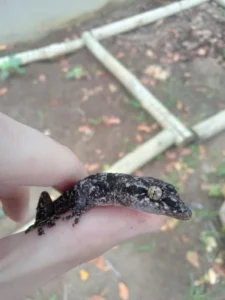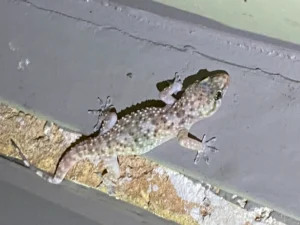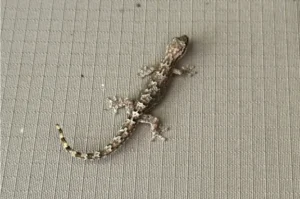You turn on the bathroom light late at night, and something small darts out of the drain. It’s quick, pale, and gone before you can even blink. You might wonder, do geckos really live in drains, or was that little creature just passing through?
Yes, some geckos can live in drains, but it’s not their first choice. Drains can offer warmth, moisture, and plenty of insects, which geckos like. They usually sneak in at night looking for food or shelter. However, they don’t naturally live there.
Drains are just convenient hiding spots in urban areas. Most geckos prefer walls, ceilings, or garden areas where they can climb freely and feel safe.
Why Geckos Might End Up in Drains
Drains are dark, damp, and full of hiding spots. That can attract small animals. But geckos aren’t really interested in water itself, they’re after the bugs living around it.
Geckos eat insects like cockroaches, mosquitoes, and drain flies. These bugs often hang out near sinks, pipes, and showers. So when a gecko shows up in a drain, it’s usually following food.

Picture a house gecko patrolling your bathroom wall. It spots a tiny fly near the sink, darts after it, and slips into the drain. Inside, it finds cracks and tunnels that lead to other rooms or even outside.
For a gecko, that’s like discovering a secret maze full of snacks.
Still, drains aren’t a place to stay for long. They’re cold, slippery, and unpredictable. Water can rush through at any moment, washing away insects, and anything else in its path.
What Kind of Geckos You Might See Near Drains
Not all geckos wander into homes, but a few species handle life near humans pretty well. These are the ones you might see near bathrooms, kitchens, or drain openings:
-
Common house gecko (Hemidactylus frenatus) – Small, pale, often clinging to walls near lights where bugs gather.
-
Mediterranean house gecko (Hemidactylus turcicus) – Likes cracks, tiles, and damp corners in warmer areas.
-
Mourning gecko (Lepidodactylus lugubris) – Found in tropical regions, reproduces without males, sometimes wanders indoors.
These geckos are flexible. They can survive in the wild or in cities, as long as there’s warmth and food. But even they wouldn’t pick a drain as a home, it’s more like a quick pit stop to hide, eat, or move unseen.
How Geckos Move Through Drain Systems
You might wonder how a gecko even gets into a drain. It’s simpler than you think.
Most home drains aren’t fully sealed. Gaps around pipes, floor grates, or under sinks are just big enough for a small gecko to squeeze through. Their soft bodies, flexible ribs, and strong toes make it easy.
Once inside, they use sticky toes to cling to smooth surfaces, even upside down. They can scuttle along tiles or metal pipes as easily as walls or ceilings.

But drains are tricky. They’re slippery from condensation and covered in stuff geckos can’t always grip.
A drain might look like a tunnel, but for a gecko, it’s a maze full of dead ends, sudden drops, and risky surprises (like water rushing through or bugs leading them too far).
Still, curiosity and hunger sometimes push them further than they should go.
Do Geckos Get Trapped in Drains?
Yes, sometimes they do.
A gecko that goes too far into a pipe can struggle to climb back, especially if the surface is wet or slippery. They can get stuck, tired, or even drowned if water flows suddenly.
Many people have found tiny geckos in sinks, bathtubs, or toilets, usually alive but confused. These aren’t sewer dwellers; they’re lost travelers who took a wrong turn.
If you find one, gently guide it out with a paper towel or cup and release it near a wall or window. Geckos are harmless, and helping one avoid a slow, stressful death is easy.
Why Drains Look So Tempting to Geckos
At first, a drain seems like a dark, safe hole; perfect for hiding from sunlight, cats, or other predators. The air is cooler, and the smell of insects drifts up.
For a gecko, that feels like an opportunity.

In some homes, especially in tropical or coastal regions, drains are open enough that insects and moisture attract geckos. A gecko might slip in just to hunt, rest, or escape the heat outside.
They’re not trying to move into your plumbing, they’re just doing what they’ve evolved to do: explore, hunt, and survive.
Can Geckos Really Survive Inside a Drain?
Only for a short time.
Drains don’t give steady warmth or easy food. They’re damp and often cold. There’s no light, and going too far down makes it hard to escape.
A gecko in a drain risks dehydration and hunger. It might catch a few insects, but it can’t really live there. Water or cleaning chemicals can hurt its delicate skin and lungs.
So a drain is just a temporary stop, like a traveler taking shelter in a cave during a storm. Safe for a moment, but not a home.
Why You See Geckos Around Bathroom or Kitchen Drains
If you see geckos near your drains, it usually means insects and moisture are nearby.
Geckos follow food. Drain flies, cockroaches, or ants breeding in pipes attract them naturally. Sometimes, a gecko near a drain didn’t even come from it, it just crawled down from a wall or ceiling after sensing prey.
In this way, geckos act like little pest control agents, helping cut down on bugs you might otherwise struggle to get rid of.
Are Geckos Dangerous Near Drains?
Not at all.
Geckos don’t damage pipes, carry diseases that easily spread to humans, or bite unless you handle them roughly. They don’t chew materials or clog drains. The only issue might be tiny droppings, which you can clean.

Actually, having geckos around often means fewer insects, especially in humid areas where bugs thrive. Some people even welcome them indoors for that reason.
If you’d rather not see them near your sinks, there are safe ways to keep them out.
How to Keep Geckos Out of Drains (Without Hurting Them)
Since geckos enter drains mostly by accident or to hunt bugs, you can stop both to keep them away.
-
Cover open drains – Use fine mesh covers or tight-fitting drain caps
-
Reduce insects – Clean drains with boiling water or mild vinegar to discourage flies
-
Seal gaps around pipes – Fill cracks near walls or tiles where geckos might squeeze through
-
Reduce humidity – Keep bathroom doors open after use and wipe wet surfaces
-
Avoid harsh chemicals – These hurt geckos and helpful insects that control pests naturally
No traps or repellents are needed. Once food and moisture disappear, geckos lose interest quickly.
Can Geckos Come Up Through Plumbing?
It’s rare, but not impossible.
Modern plumbing usually has water traps and U-bends that block anything from crawling up. But in older or poorly sealed systems (especially outdoors) a gecko could climb in and end up inside.

This happens more in warm regions where outdoor plumbing connects directly to kitchens or bathrooms. A gecko might slip in through a vent or pipe crack and appear later.
Still, most geckos you see near drains came from above, not below.
What Happens When Geckos Get Washed Away?
Sometimes, water flows through a drain and pushes a gecko deeper into the pipes. Some survive if there’s an open outlet, like a garden drain. Others don’t.
This is another reason to keep drains covered, not just for plumbing, but to protect small creatures. They don’t know how dangerous that tunnel can be until it’s too late.
What Geckos Really Need to Survive
Drains don’t make good homes because geckos need:
-
Warmth – Most are tropical and need steady warm temperatures
-
Dry surfaces – They need places to climb and bask, not slippery metal or wet tiles
-
Food – Bugs are easier to find near light, not deep in pipes
-
Shelter – Cracks, ceilings, and walls offer more safety than pipes
Drains fail at almost all of these. They’re fine for a quick hide, but not a real home.
Frequently Asked Questions
Do geckos come out of drains?
Yes, geckos do come out of drains, usually at night when they’re hunting insects or looking for a dry spot to rest. They aren’t permanent residents, they just explore the area and leave when they’ve found food or shelter.
Why do geckos go into drains?
Geckos go into drains mainly for moisture, warmth, and insects. Drains can be full of tiny bugs, and the damp environment can help them stay hydrated. It’s less about living there and more about taking advantage of a convenient snack or hiding place.
Can geckos get trapped in drains?
Yes, geckos can get trapped if the drain is slippery, deep, or has no easy exit. Their tiny claws help them climb, but some drain designs make escape difficult, especially if there’s flowing water or smooth surfaces.
Can geckos survive in drains?
They can survive temporarily if there’s enough food and moisture, but drains aren’t ideal long-term habitats. Limited space, fluctuating water levels, and lack of proper hiding spots make it stressful, and a gecko won’t thrive there indefinitely.
Conclusion
Geckos don’t live in drains, but they sometimes pass through while hunting or looking for shelter. They follow insects, moisture, or the quiet safety of hidden spaces. Drains are risky, cold, wet, and full of dangers a small lizard can’t control.
When you see a gecko near a drain, it’s not moving in, it’s just navigating our world the best it knows how. Instinct, curiosity, and survival keep it moving through the cracks and corners of our homes.
So next time you spot one darting by the sink or hiding near the shower, remember, it’s not lost. It’s just exploring another edge of its shared world with us.
Hi, my name is Ezra Mushala, i have been interested animals all my life. I am the main author and editor here at snakeinformer.com.

